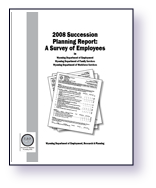Chapter 9: Factors That May Influence Job Changing
by: Lisa L. Knapp, Research Analyst
Agency employees were asked the question “Even if you do not have definite plans for leaving your department, which of the following factors, if offered by a different employer, would lead you to take a job somewhere else?” They were offered a series of 14 factors (either on paper or over the phone, see Chapter 2) and allowed to choose as many as they felt applied to their situation. Because they were allowed to choose more than one factor, the totals for each agency will not equal 100.0%.
These factors can be viewed as a sort of wish list of things that could improve job quality. There are some factors that individual agencies cannot change, such as wages or benefits, but there are also some that could easily be altered to improve employee morale and tenure. Examples of these include flexible scheduling, employee recognition, autonomy, and respect.
The Figure and Table show these factors and the percentage of respondents in all three agencies that chose them. The most influential factors for all employees were wages (81.3%), opportunities for advancement (48.7%), benefits (42.8%), flexible scheduling (37.3%), and more opportunities for training and education (33.5%). The least important factors for all employees included fewer non-job-related tasks (5.6%), autonomy (7.4%), location (10.2%), and a better quality of work produced by the agency (10.8%).
Several issues crosscut agencies as important factors in the decision to change jobs. In each of the three agencies, wages, opportunities for advancement, benefits, and flexible scheduling options were among the most often chosen factors that would affect this decision. There were, however, some differences among agencies. For instance, as the Figure shows, more Department of Family Service (DFS) employees (26.4%) chose better staffing, which would include more employees to cover the workload and better supervisor-employee relationships, as a factor that could influence a job change than in the Department of Employment (DOE) or the Department of Workforce Services (DWS). Among DOE employees autonomy was chosen more often (11.6%) than among DWS employees (7.4%) or DFS employees (5.5%). And DWS employees were more likely to indicate that the quality of work produced by the agency was a factor that could influence their decision to move (13.2%), a factor that was less important in DFS (11.2%) or DOE (7.8%).
Many of these issues appear in other sections of this report. For instance, this analysis shows wages, benefits, and advancement to be among the most important factors to job changing in all three agencies. In Chapter 4, we found that employees in all three agencies were unhappy with their wages and the perceived lack of opportunities for advancement within their jobs, among other things.
The chi-square analysis found that employees in DFS were unhappy with the amount of time they have to complete their work (see Chapter 4, Table 21). As indicated in the comments from these employees, this may be because there are fewer staff members to cover an increasing caseload and more job-related stress. According to the analysis of turnover (see Chapter 6, Figure 1), the number of employees in DFS has been steadily increasing over the past several years, but perhaps not fast enough. This analysis indicated that the opportunity for a workplace with better staffing was a more important factor in job changing for these employees than for employees in DOE or DWS, possibly because of increased stress levels.
Similarly, this analysis indicated that increased job autonomy was a more important factor in the decision to change jobs for employees in DOE than for employees in either of the other agencies. This is supported to a degree in the chapter on Workplace Satisfaction (see Chapter 4, Table 14), where it was found that a sizeable proportion of DOE employees disagreed with the statement “I have some control over what I am supposed to accomplish (my job objectives).”

